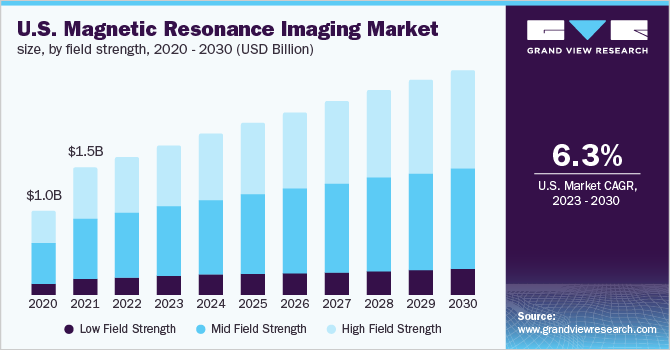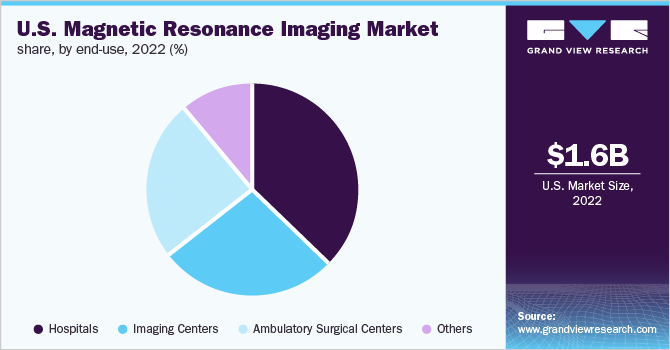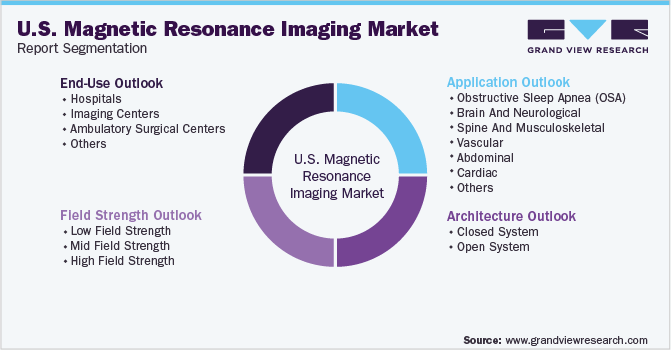- Home
- »
- Medical Devices
- »
-
U.S. Magnetic Resonance Imaging Market Size Report, 2030GVR Report cover
![U.S. Magnetic Resonance Imaging Market Size, Share & Trends Report]()
U.S. Magnetic Resonance Imaging Market (2023 - 2030) Size, Share & Trends Analysis Report By Architecture, By Field Strength, By Application (Brain & Neurological, Vascular), By End-Use, By Region, And Segment Forecasts
- Report ID: GVR-4-68040-019-2
- Number of Report Pages: 107
- Format: PDF
- Historical Range: 2018 - 2021
- Forecast Period: 2023 - 2030
- Industry: Healthcare
- Report Summary
- Table of Contents
- Segmentation
- Methodology
- Download FREE Sample
-
Download Sample Report
Report Overview
The U.S. magnetic resonance imaging market size was valued at USD 1.62 billion in 2022 and is expected to expand at a compound annual growth rate (CAGR) of 6.3% from 2023 to 2030. Magnetic resonance imaging (MRI) scans are highly recommended for the accurate detection of abnormalities in the neurological area, musculoskeletal region, abdomen, cardiac, and breasts. The MRI scans in the U.S.is expected to grow by 18.3% by 2030 to reach a total scan volume of 33.1 million. The ongoing research to develop minimally invasive MRI systems, the introduction of AI tools to ease radiologist’s workload, and the development of MRI artifact stabilization software, are the current market trends, boosting market growth. Factors such as increased use of integrated systems (PET/MRI), precise and accurate detection of soft tissues, and rise in cancer and cardiac cases, are responsible for the market growth. GE Healthcare suggests that ~2.8 million people are diagnosed with traumatic brain injury (TBI) each year in the U.S. Thus, the need to develop MRI scanners to detect TBI is creating growth opportunities for the new entrants and top players in this market.

Introduction of AI within the MRI systems enables the reduction of MRI scan time, improves imaging efficiency, and reduce rescans. For instance, Siemens Healthineers, joined forces with Heart Vista, to introduce their AI-guided software in the MRI scanners offered by the former. The software is enabled with 510k clearance AI for one-click cardiac localization that can be incorporated within Siemens Healthineers and GE Healthcare MRIs. Thus, the incorporation of AI will allow precise image quality, improved patient satisfaction, and enhanced ability to conduct a large number of MRI scan in a day without any rescans. Thus, AI is the future in MRI scans and is responsible for the high market growth.
Due to the outbreak of COVID-19 in 2020, the market experienced a dip by ~40.0% as compared to the previous year. Reduction in diagnostic scans, decline in sales of newer MRI systems, economic setback experienced by the hospitals and diagnostic centers, fear of viral spread, lack of skilled technicians, halt in logistics, reduced production capacity due to the national lockdowns, were some major reasons for the market dip.
Studies published by GE Healthcare suggest that the patients affected during the pandemic, show lasting symptoms for the months post negative COVID-19 tests. Nearly 30.0% of the 28.0 million COVID-19 cases recorded in the U.S., experienced long-term symptoms. Thus, the use of MRI system along with other imaging modality allowed providers to monitor patients’ recovery and search for the underlying causes of lasting symptoms. This led to the increased scanning frequency using MRI, boosting the market growth post Q2 2021.
Architecture Insights
The closed systems segment held the largest share of 71.0% in 2022. Precise images are created using closed MRI systems as they employ strong magnetic field and high radiofrequency waves. A closed MRI structure permits accurate analysis and precise slice selection. One of the major drawbacks of these systems is the tremendous noise. Thus, patients in these closed MRI systems may experience claustrophobia and other mental disturbances.
The open MRI systems showed the highest growth rate of 7.6% CAGR. Numerous market players focus on the development of these systems as it overcomes the issues of closed MRI systems. Pediatric patients are mainly diagnosed in these systems as it eliminates the effect of claustrophobia and anxiety. However, certain diagnostic areas can’t be appropriately scanned using these systems, thus, radiologists prefer closed MRI systems.
Field Strength Insights
The mid field strength accounted for the largest share of ~48.0% in the field strength segment. Most MRI scans are conducted in MRI systems magnitude of 1.5T to 3.0T. Optimum absorption rate, accuracy of images with reduced frequency of multiple scans, implant safety, affordable scanning cost, ease of working, and high usage rate of the radiation technician, are the factors for the large market size.
High field strength is expected to witness the highest CAGR of 7.6% during the forecast period. High field strength is gaining large research potential due to their ability to scan even critical areas and produce accurate images. These systems produce 7.0T magnetic strength and numerous market leaders have received FDA clearance for the market launch. For instance, GE Healthcare’s Signa 7.0T MRI system was approved by the FDA in 2020 for use in research and clinical setting to efficiently identify neurological and musculoskeletal diseases.
Application Insights
The brain and neurological segment accounted for the largest share of ~22.5% in 2022. Radiologists often prefer MRI scans over other imaging modalities due to the better scan quality and identification of minute abnormalities. Breast imaging held the second largest share due to the growing prevalence of the disease and need to identify risk factors related to the disease.
Breast cancer is highly prevalent in females than any other cancer. Nearly 264,000 cases of breast cancer in women are diagnosed each year and 42,000 women die due to inappropriate diagnosis. Therefore, MRI techniques help in providing quantitative information about cancer by identifying the biological and physical properties of the tissue. MRI is rapidly becoming the preferred method for spinal and musculoskeletal imaging.
End-use Insights
The hospital segment accounted for the largest share of ~37.2% in the end-use segment. Presence of skilled staff, improved diagnostic capabilities, high reimbursement ratio, and increased admission rate for emergency cases, are the factors responsible for its large market size. Imaging center market is expected to expand with the highest CAGR of 7.9% during the forecast period. Increased series of funding from a venture capitalist, collaboration with large hospitals, inclination towards affordable diagnostic testing, are the factors propelling the system growth during the forecast period.

The ambulatory care centres segment is also expected to experience a significant growth rate during the forecast period. Growing government initiatives to improve and increase the number of ambulatory care centres to increase reach in rural areas are the factors expected to propel the segment growth during the forecast period.
Key Companies & Market Share Insights
Companies like GE Healthcare, Toshiba, Hologic Inc., Phillips, Siemens Healthineers, are the top players of this market. These companies are investing in product research, product launches and conduct clinical trials to determine the clinical efficacy of these systems. For instance, GE received FDA clearance for its 7.0T MRI systems named SIGNA. It is the most powerful MRI system (5 times more powerful than any other scanner system) available for human use. Some of the prominent players in the U.S. magnetic resonance imaging market include:
-
GE Healthcare
-
Siemens AG
-
Toshiba Corporation
-
Aurora Imaging Technologies, Inc.
-
Koninklijke Philips N.V.
-
Esaote SPA
-
Sanrad Medical Systems Pvt ltd
-
Fujifilm
U.S. Magnetic Resonance Imaging Market Report Scope
Report Attribute
Details
Market size value in 2023
USD 1.76 billion
Revenue forecast in 2030
USD 2.6 billion
Growth rate
CAGR of 6.3% from 2023 to 2030
Base year for estimation
2022
Historical data
2018 - 2021
Forecast period
2023 - 2030
Quantitative units
Revenue in USD million, CAGR from 2023 to 2030
Report coverage
Revenue forecast, company ranking, competitive landscape, growth factors, trends
Segments covered
Architecture, field strength, application, end-use
Country Scope
U.S.
Key companies profiled
GE Healthcare; Siemens AG; Toshiba Corporation; Aurora Imaging Technologies, Inc.; Koninklijke Philips N.V.; Esaote SPA; Sanrad Medical Systems Pvt ltd.; Fujifilm
Customization scope
Free report customization (equivalent up to 8 analyst’s working days) with purchase. Addition or alteration to country, regional & segment scope
Pricing and purchase options
Avail customized purchase options to meet your exact research needs. Explore purchase options
U.S. Magnetic Resonance Imaging Market Segmentation
This report forecasts revenue growth at country level and provides an analysis of the latest industry trends in each of the sub-segments from 2018 to 2030. For this study, Grand View Research has segmented the U.S. magnetic resonance imaging market report based on the architecture, field strength, application, and end-use:

-
Architecture Outlook (Revenue, USD Million, 2018 - 2030)
-
Closed System
-
Open System
-
-
Field Strength Outlook (Revenue, USD Million, 2018 - 2030)
-
Low Field Strength
-
Mid Field Strength
-
High Field Strength
-
-
Application Outlook (Revenue, USD Million, 2018 - 2030)
-
Obstructive Sleep Apnea (OSA)
-
Brain And Neurological
-
Spine And Musculoskeletal
-
Vascular
-
Abdominal
-
Cardiac
-
Breast
-
Other
-
-
End-Use Outlook (Revenue, USD Million, 2018 - 2030)
-
Hospitals
-
Imaging Centers
-
Ambulatory Surgical Centers
-
Others
-
Frequently Asked Questions About This Report
b. The U.S. magnetic resonance imaging market size was estimated at USD 1.62 billion in 2022 and is expected to reach USD 1.76 billion in 2023.
b. The U.S. magnetic resonance imaging market is expected to grow at a compound annual growth rate of 6.3% from 2023 to 2030 to reach USD 2.6 billion by 2030.
b. Brain and neurological dominated the MRI market with a share of 22.4% in 2022. This is attributable to factors such as superior quality scans as compared to CT imaging.
b. Some key players operating in the U.S. MRI market include GE Healthcare, Siemens AG, Toshiba Corporation, Aurora Imaging Technologies, Inc., Koninklijke Philips N.V., Esaote SPA, Sanrad Medical Systems Pvt ltd, Fujifilm
b. Key factors that are driving the U.S. magnetic resonance imaging market growth include advancements in diagnostic techniques, such as open MRI, visualization software, and superconducting magnets.
Share this report with your colleague or friend.
Need a Tailored Report?
Customize this report to your needs — add regions, segments, or data points, with 20% free customization.

ISO 9001:2015 & 27001:2022 Certified
We are GDPR and CCPA compliant! Your transaction & personal information is safe and secure. For more details, please read our privacy policy.
Trusted market insights - try a free sample
See how our reports are structured and why industry leaders rely on Grand View Research. Get a free sample or ask us to tailor this report to your needs.










